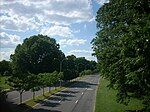Union Turnpike (New York)

Union Turnpike is a thoroughfare stretching across part of Long Island in southern New York state, mostly within central and eastern Queens in New York City. It runs from Myrtle Avenue in Glendale, Queens, to Marcus Avenue in North New Hyde Park, Nassau County, about 1 mile (1.6 km) outside New York City border. The name memorializes the Union Racetrack, once a famous attraction for Queens residents. Union Turnpike from Myrtle Avenue to the Nassau County border is 9.2 miles (15 km) long. The turnpike crosses into Nassau County at the city's easternmost point on Langdale Street, two blocks past the city's highest-numbered street (271st Street). North of the turnpike at this point is Glen Oaks and south of it is Floral Park, both sharing the same ZIP code (11004). It then enters the hamlet of North New Hyde Park.
Excerpt from the Wikipedia article Union Turnpike (New York) (License: CC BY-SA 3.0, Authors, Images).Union Turnpike (New York)
Union Turnpike, New York Queens County
Geographical coordinates (GPS) Address External links Nearby Places Show on map
Geographical coordinates (GPS)
| Latitude | Longitude |
|---|---|
| N 40.732138888889 ° | E -73.767972222222 ° |
Address
Union Turnpike
Union Turnpike
11364 New York, Queens County
New York, United States
Open on Google Maps




